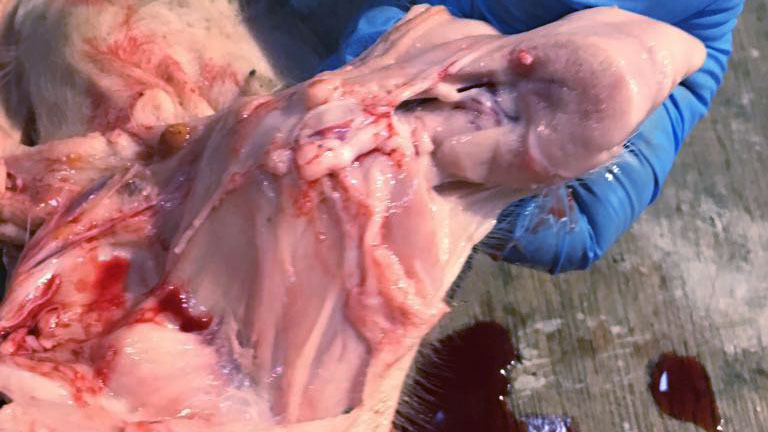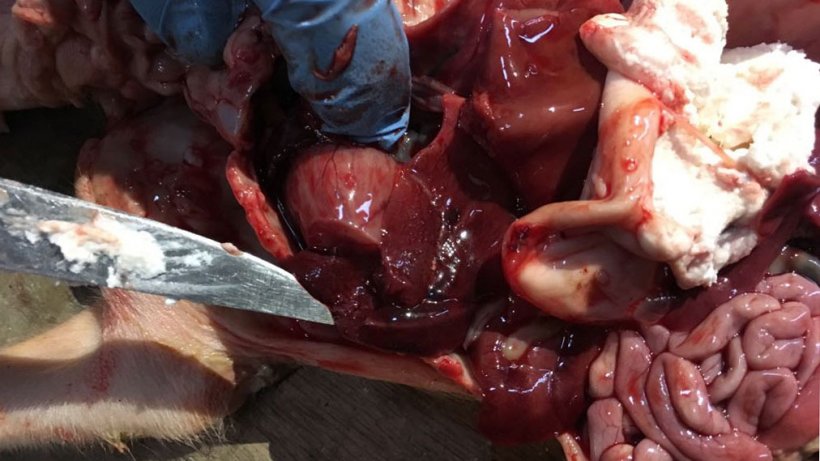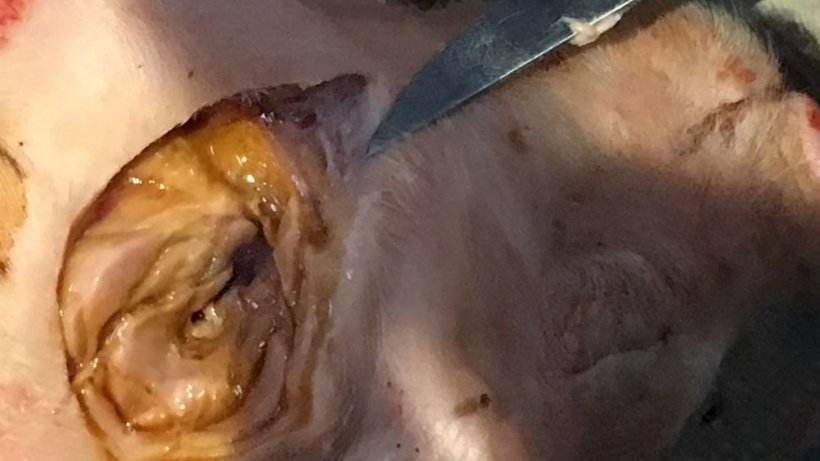Introduction
The farm is a commercial 150 farrow to finish sow unit in Northern Ireland.

The vaccination protocol implemented is illustrated in Table 1.
Table 1. Vaccination programme.
| Vaccine | Gilts | Sows | Boars | Piglets |
|---|---|---|---|---|
| Parvovirus | 2 ml injection @ selection | 2 ml injection 2 weeks post farrowing | 2 ml injection twice a year | |
| Erysipelas | 2 ml injection @ selection and 2 weeks pre service | 2 ml injection 2 weeks post farrowing | 2 ml injection twice a year | |
| Atrophic Rhinitis | 2 ml injection 6 and 2 weeks pre farrowing | 2 ml injection 2 weeks pre farrowing | ||
| Enzootic Pneumonia | 1 ml @ 7 days and @ weaning |
Replacement gilts are produced internally. Boars are used for heat detection. Gilts and sows are served using artificial insemination from a single source. The unit does a three-week batch farrowing cycle.
The farm grows its own barley and wheat, but purchases soya and the vitamin-mineral premix. It prepares a meal feed for the entire unit except for the weaner rations.
The closest pig unit is 6 km away.
History
The farmer contacted his veterinarian concerning an increase in piglet mortality within the first 4 days of life. In many cases, the entire litter died.
Investigation
Clinical Investigation
During a farm visit in April 2018, there were 17 dead piglets around 4 days of age from different litters. All dead piglets had good body condition but were pale (Figure 1). Necropsies were performed on five dead piglets. The post-mortem examination showed haemoperitoneum caused by hepatic rupture in all five piglets. The stomachs were filled with clotted milk (Figures 2 & 3). There was damage to the muscles around the injection site of the iron dextran showing oedema and brownish black discoloration (Figure 4).
The farmer pointed out that some piglets developed an anaphylactic reaction within 24 hours after injecting 1 ml of iron dextran in the neck. Some piglets died suddenly after being injected with iron dextran.
The total mortality in the last two batches of piglets was 25%.

Figure 1. Four-day-old piglets with pale muscles.

Figure 2. Four-day-old piglet with haemoperitoneum & haemothorax with full stomach.

Figure 3. Four-day-old piglet with hepatic rupture and friable liver.

Figure 4. Four-day-old piglet with damage to the muscles around the injection site (neck) showing oedema and brownish black discoloration.
Laboratory Investigations
Two dead piglets were submitted to the laboratory for analyses.
The laboratory investigations of the livers are summarized in Table 2.
| Piglet | Post-mortem findings |
Bacteriological findings | Biochemical findings |
|---|---|---|---|
| 1 | Good body condition Haemohydrothorax Haemohydroperitoneum Pale liver |
No growth | Selenium (Liver):
|
| 2 | Good body condition Haemohydrothorax Haemohydroperitoneum Pale liver Hepatic rupture |
No growth | Selenium (Liver):
|
In April 2018 a sample of the mineral and vitamin sow premix was sent to a certified laboratory to analyze the level of vitamin E. The level of vitamin E in the vitamin-mineral premix bag was 1270 mg/kg. At the recommended inclusion rate of 25 kg to a tonne of sow feed, the level of vitamin E in the lactating and dry sow diets was 31.75 mg/kg.
Differential diagnosis
Based on the clinical and laboratory investigations, a list of differential diagnosis was prepared as follows:
- Iron toxicity in piglets due to low level of vitamin E in sow diets.
- Warfarin poisoning.
- Thrombocytopenia purpura.
A diagnosis of iron toxicity in piglets due to low level of vitamin E in sow diets was reached based on the history and consistent clinical and laboratory investigations.
Control programme
An emergency protocol for correcting the low level of vitamin E in the sows was implemented, as follows:
- Inject sows with vitamin E/selenium according to the manufacturers’ recommendations a week before farrowing.
- Inject all piglets with vitamin E/selenium according to the manufacturers’ recommendations when injecting iron dextran.
- Increase the vitamin E level in the sows’ diets to a minimum of 100 mg/kg in the final mixed meal offered to the sow.
Response to the control program
Piglet mortality stopped after injecting vitamin E/selenium with the iron dextran. This practice was done for 2 farrowing batches.
A sample of the sow mineral and vitamin premix bag was sent to a certified laboratory to analyze the level of vitamin E in June 2018. The level of vitamin E in the premix was 2852 mg/kg. At the recommended inclusion rate of a 25 kg-bag added to a tonne of sow feed , the level of vitamin E in the lactating and dry sow diets was 71.3 mg/kg.
Piglet mortality within 24 hours post-iron dextran injection has stopped since the implementation of the control program.
Discussion
Reports of toxicity after injection of iron dextran in piglets are rare. However, toxicity does occur occasionally. Clinical signs appear 2 to 4 hours after injection; in other cases death is delayed 2 – 4 days (Muirhead et al., 1997a; Cromwell, 2019). Damage to the muscles around the injection site causes potassium, among other substances, to be released. Blood potassium rises and interferes with cardiac function. The whole litter is affected and piglets appear anaemic, become weak, lame, and have muscle tremors followed by convulsions. Respiratory distress may be seen. There is swelling at the injection site. On necropsy, skin and muscles may appear pale, and there is oedema and brownish black discoloration at the injection site. Degeneration of the skeletal and cardiac muscle may also be seen (Cromwell, 2019). Most of these clinical signs occurred in this clinical case.
The most important precipitating factor in iron toxicosis in pigs is low vitamin E or selenium levels in the sow. Pigs would be born deficient in vitamin E or selenium or the colostrum will not be able to provide adequate amounts of these nutrients to meet the antioxidant needs of the piglets (Muirhead et al., 1997a; Cromwell, 2019).
A major fire on October 31st, 2017 at one of the world’s primary suppliers of Vitamins A and E put pressure on supplies and resulted in higher prices in 2018 (BASF, 2017; Driver, 2017). This shortage of vitamin E could have resulted in the mill company reducing the vitamin E levels in pig diets. The recommended level of vitamin E level in dry and lactating sow diets is not less than 80 – 100 mg/kg (Muirhead et al., 1997b). A nutritional formulation error is another possibility. Either way, this led to piglets being born susceptible to iron toxicosis.
Piglets are born with a selenium content in the liver of 1.6 – 2.6 mg/kg original matter. During the suckling period the selenium content drops down to a minimum level of 0.3 mg/kg original matter (Puls, 1994). The selenium levels detected in the livers of the submitted piglets was within the reference range (Table 2).
The reference range for vitamin E in the liver for piglets (1 – 30 days of life) is 12 - 20 mg/kg dry matter (Puls, 1994). The vitamin levels of 0.988 and 2.86 mg/kg dry matter detected in the liver of the submitted piglets was significantly below this range (Table 2).
Vitamin E has a positive effect on fertility of sows (Muirhead et al., 1997c). However, there were no fertility problems in this unit during this period of time.




